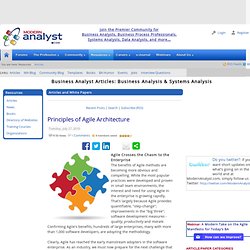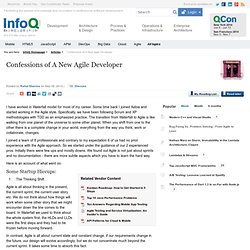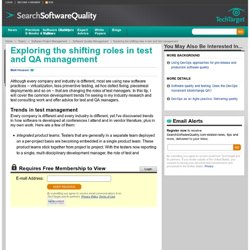

QA & Testing. Definition of Done: A Reference. An Agile project has ceremonies (sprint planning, release planning, sprint retrospective, etc.) and metrics (sprint & release burndown charts) designed to ensure that the project is in a healthy state.

Unfortunately, many Agile projects fail even after following all the ceremonies religiously. Why? One of the primary reasons is that they are not able to deliver value to the customer at the end of each sprint. They deliver a product at the end of each sprint, but not a product that is potentially shippable. Here lies the root cause of failure. An explicit and concrete definition of done may seem small but it can be the most critical checkpoint of an agile project.
Before we explore a definition for done, it is important to define another Scrum term: potentially shippable product. Principles of Agile Architecture. Agile Crosses the Chasm to the Enterprise The benefits of Agile methods are becoming more obvious and compelling.

While the most popular practices were developed and proven in small team environments, the interest and need for using Agile in the enterprise is growing rapidly. That's largely because Agile provides quantifiable, "step-change"; improvements in the "big three"; software development measures - quality, productivity and morale. Confirming Agile's benefits, hundreds of large enterprises, many with more than 1,000 software developers, are adopting the methodology. Clearly, Agile has reached the early mainstream adopters in the software enterprise. As an industry, we must now prepare for the next challenge that these methods present. In this paper we'll discuss one of the factors, the role of "Intentional Architecture"; in the development of enterprise-class systems built using agile methods and techniques. Refactoring Large-Scale Systems Refactoring is a case in point. Agile Testing. Confessions of A New Agile Developer.
I have worked in Waterfall model for most of my career.

Some time back I joined Xebia and started working in the Agile style. Specifically, we have been following Scrum and XP methodologies with TDD as an emphasized practice. The transition from Waterfall to Agile is like walking from one planet of the universe to some other planet. When you shift from one to the other there is a complete change in your world, everything from the way you think, work or collaborate, changes. I joined a team of 8 professionals and contrary to my expectation 6 of us had no prior experience with the Agile approach. Here is an account of what went on: Some Startup Hiccups: The Thinking Shift Agile is all about thinking in the present, the current sprint, the current user story etc. In contrast, Agile is all about current state and constant change, if our requirements change in the future, our design will evolve accordingly; but we do not concentrate much beyond the current sprint.
Changing Gears. Lisa Crispin « Test Side Story. In october I attented the Agile Testing Days in Berlin. The program committee assembled a really great line-up (see the 2009 programme here). Here is my write-up of the event. A late one, I admit, but it certainly was worth writing about. So without any further ado, here goes… October 11 I arrived in Berlin late sunday evening. October 12 (c) 2009 Crispin & Gregory First day of the conference. Ten Principles for Agile Testers. Source: Crispin, Lisa, and Gregory, Janet. Agile Testing: A Practical Guide for Testers and Agile Teams, Addison-Wesley, 2009. Lisa Crispin and Janet Gregory wrote the recently-published Addison-Wesley book Agile Testing, a thick tome that fills a much-needed gap in agile literature. Prior, detailed guidance for testing in an agile environment was sparse. With Agile Testing and a couple other fairly recent books (2007's Test Driven: TDD and Acceptance TDD for Java Developers by Lasse Koskela and Bridging the Communication Gap: Specification by Example and Agile Acceptance Testing by Gojko Adzic, 2009), we now have a good foundation for comprehensive agile testing knowledge.
The ten principles that the authors published should sound familiar. Building Better Software › because people want their software to work. Exploring the shifting roles in test and QA management. Although every company and industry is different, most are using new software practices -- virtualization, less preventive testing, ad hoc defect fixing, piecemeal deployments and so on -- that are changing the roles of test managers.

In this tip, I will cover the common development trends I'm seeing in my industry research and test consulting work and offer advice for test and QA managers. Trends in test management Every company is different and every industry is different, yet I've discovered trends in how software is developed at conferences I attend and in vendor literature, plus in my own work. Here are a few of them: Testers that are generally in a separate team deployed on a per-project basis are becoming embedded in a single product team. Exploratory Test Assistant - a tool for recording your exploratory testing notes. Agile Testing. Ten Principles for Agile Testers. Everyone on an agile team is a tester.

Anyone can pick up testing tasks. If that’s true, then what is special about an agile tester? If I define myself as a tester on an agile team, what does that really mean? Do agile testers need different skill sets than testers on traditional teams? What guides them in their daily activities?